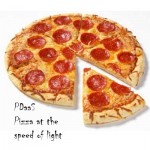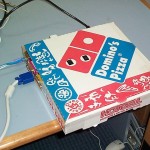Until now, the wonders of the cloud revolution and low latency connectivity have been targeted at niche industries like gaming, high speed trading, and hospitals. But now the true power of fiber and the cloud is coming to the mass markets, as major telecommunications companies quickly move beyond server instances and backup infrastructure to standardize a revolutionary new cloud service with real potential to stem those landline revenue declines: high speed pizza delivery.

The new cloud-powered Pizza-Delivery-as-a-Service (PDaaS) will make it possible for restaurants, snack bars, and even homeowners to create Virtual Pizza Ovens on demand, without having to invest in and manage heavy duty industrial restaurant equipment equipment and can focus their efforts on making the very best pizza they can. By leveraging the latest low latency fiber connectivity and those automated voicemail systems carriers are so good at nowadays, the latency between the order and actual pizza consumption could be cut by hundreds if not thousands of milliseconds — a far larger effect than the financial vertical even hopes to see. Enterprises will be able to scale both the size and quantity of their virtual pizza ovens to meet unexpected demand in unheard of intervals, bringing a swift end to the era of 30 minutes or less.
Carrier-neutral datacenter operators are jumping all over this as well, given the obvious synergies between contanierized modular datacenters and fast food franchising. The ability to deliver a datacenter module to any parking lot in mere days means that we can also deliver a substantial amount of heat energy. By carefully placing specially designed modules at the triple nexuses of fiberoptic cables, residential access roads, and the power grid, they can simultaneously optimize communications latency, delivery latency, and processing latency. That means pizzas arrive faster, cheaper, and they taste better too. Extra server capacity can then serve the data needs of the surrounding community.
 The effort also appeals to environmentalists due to its potential for recycling so many outdated pizza boxes into actually carrying pizzas, as well as the obvious benefits in helping the industry lower its carbon footprint. To save power on cooling, server heat generated both by each module’s servers will be redirected to help heat the pizza ovens. With a proper balance of pizza demand and regional cloud services demand, you can power one of these with a couple of hamster wheels – although actually having hamsters in the module would violate sanitary standards of course. The first customers will probably be universities eager to simultaneously add massive computing power, achieve energy efficiency, and satisfy the pizza appetites of their student body.
The effort also appeals to environmentalists due to its potential for recycling so many outdated pizza boxes into actually carrying pizzas, as well as the obvious benefits in helping the industry lower its carbon footprint. To save power on cooling, server heat generated both by each module’s servers will be redirected to help heat the pizza ovens. With a proper balance of pizza demand and regional cloud services demand, you can power one of these with a couple of hamster wheels – although actually having hamsters in the module would violate sanitary standards of course. The first customers will probably be universities eager to simultaneously add massive computing power, achieve energy efficiency, and satisfy the pizza appetites of their student body.
Although the FCC has not made any official statements on the subject, the commissioners are said to be giddy with excitement about the possibility that PDaaS could finally be the driving force that will bring FTTH to every house in the land. “Hell, we’ve tried everything else it seems, but somewhere along the way we forgot that the way to a society’s technological pocketbook runs through its teenagers’ stomachs. Nothing will drive fiber demand better than a high-latency pizza delivery experience.” And besides, is there any industry that America has a bigger lead in than high speed pizza delivery?
The incumbent providers and cable MSOs are leading the charge, which makes sense because for pizza delivery you have to be everywhere in town or you’re nobody. But not content to let the incumbents take over the high speed food delivery market completely, next generation carriers are looking for an angle to break into the market too. Level 3, for instance, is said to be trialing the usage of spare metro conduits for even faster delivery of burritos and stromboli, cutting out the need for delivery vehicles and personnel. Additionally, friction in the conduit will be carefully managed to keep each burrito at the perfect temperature until arrival. Zayo’s purchase of AboveNet also puts them in a stronger position to compete for similar opportunities with all that Tier-1 metro conduit.
But there are less uplifting motives behind the scenes than delivering mouth-watering pizzas to needy teenagers. One industry executive was overheard to say “Actually we just needed something popular, heck anything, that doesn’t a have a freaking ‘i’ in front of it that parents will buy their kids to shut them up. You know, so someone other than Apple can make money at it. That bunch of Starbucks and Whole Foods hippies don’t understand pizza the way we do. Besides, we’d really love to see an iPhone melt down every time Siri gets asked ‘Where can I buy a pizza near here’.”
However others may have sensed the same opportunity to finally beat Apple to the punch for once. Sources say Google is said to be readying the purchase of 2,795 patents from Dominos to serve as a patent umbrella for a top secret new product that they swear they’ll finally keep secret this time. Oops.
If you enjoyed this piece, please share it! Alternatively, you could also check out past installations, such as Level 3′s Crowe Achieves Enlightenment and DeepBore Networks To Take NYC-Chicago Latency Lower Than Ever?
If you haven't already, please take our Reader Survey! Just 3 questions to help us better understand who is reading Telecom Ramblings so we can serve you better!
Categories: Fun






Sorry, I couldn’t help myself.
The names mentioned in this article stand out as supreme pizzas ready made for Internet high speed delivery.
Zayo’s purchase of AboveNet, combined with Level 3 and Google make the best take out order in the telecom industry.
Warren Buffett will even give a free six pack of coke with every pizza.
Pizzas and Stromboli delivered through Level 3 and some others’ pipes? Hmm, I guess that’s more productive than “white mice” running aimlessly through them into perpetuity.
Rob, did you confer with Donna Jaegers of Dean Davidson over intellectual property rights before embarking on this idea?
Notwithstanding the impossibilities surrounding physical transportation, the speed at which transactions may be ordered and paid for in advance of dining in or taking out, will certainly add “time” to peoples’ lives when PDaaS is tweaked towards the maximum time saving experience.
Someone point this out to XO — Their answer to employee stress during any kind of outage or other mishap is to buy everyone pizza. WIN!
Someone please point out who is that smart, from what I remember no one at the Wyo office was even that remotely smart